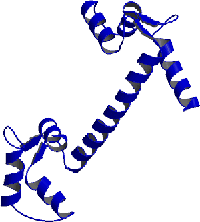The Johnson Research Group
Single-molecule Spectroscopy

The objective of our study of is to use single-molecule spectroscopy to study the binding dynamics of proteins with target peptides, conformational motions within proteins, and the mechanism of target enzyme activation by single-molecule spectroscopy. In single-molecule spectroscopy, a protein molecule is labeled with a highly fluorescent dye (or, for some experiments, two dye molecules). Then, the fluorescence of the molecules is observed individually by laser excitation in a fluorescence microscope. A "trajectory" of the fluorescence signal from the molecule is recorded. Since fluorescence is sensitive to the environment and conformation of the protein, this trajectory can be analyzed to find information about the function of the protein. Modifications of this approach make it possible to measure fluorescence lifetimes, orientational mobilities, and intramolecular distances in single protein molecules.

The system we are currently studying is the calcium signaling protein, calmodulin (CaM), which functions to activate target enzymes in response to a calcium signal. Calmodulin possesses the unique ability to bind strongly and specifically to a wide variety of different target enzymes, which is related to its structural flexibility and heterogeneity. We are currently studying the conformational substates in solution of a doubly-labeled CaM mutant by Fluorescence Resonance Energy Transfer (FRET). The combination of FRET and Fluorescence Correlation Spectroscopy (FCS) allows for observation of CaM dynamics and conformations for freely diffusing CaM molecules, without the use of immobilization techniques. We have also observed single-molecule binding of CaM to peptides as well as its binding to one of its target enzymes, the plasma-membrane calcium ATPase (PMCA).
To learn more about our research follow these links:
- Polarization Modulation Studies
- Burst Fluorescence Measurements
- Fluorescence Correlation Spectroscopy (FCS)